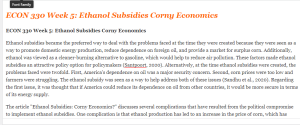ECON 330 Week 5: Ethanol Subsidies Corny Economics
ECON 330 Week 5 Ethanol Subsidies Corny Economics
Ethanol subsidies became the preferred way to deal with the problems faced at the time they were created because they were seen as a way to promote domestic energy production, reduce dependence on foreign oil, and provide a market for surplus corn. Additionally, ethanol was viewed as a cleaner-burning alternative to gasoline, which would help to reduce air pollution. These factors made ethanol subsidies an attractive policy option for policymakers (Santpoort, 2020). Alternatively, at the time ethanol subsidies were created, the problems faced were twofold. First, America’s dependence on oil was a major security concern. Second, corn prices were too low and farmers were struggling. The ethanol subsidy was seen as a way to help address both of these issues (Sandhu et al., 2020). Regarding the first issue, it was thought that if America could reduce its dependence on oil from other countries, it would be more secure in terms of its energy supply.
The article “Ethanol Subsidies: Corny Economics?” discusses several complications that have resulted from the political compromise to implement ethanol subsidies. One complication is that ethanol production has led to an increase in the price of corn, which has negative impacts on food prices and costs for industries that use corn as an input (Dooley, 2019). Additionally, the subsidies have led to a significant increase in the amount of land used for corn cultivation, which has resulted in environmental problems such as soil erosion and loss of biodiversity. Another complication is that the subsidies have not been successful in achieving their intended goal of reducing dependence on foreign oil (Somavat et al., 2018). Instead, they have primarily benefited large agribusinesses and ethanol producers, rather than small farmers or consumers. Finally, the article argues that the subsidies are inefficient and costly, and that there are more cost-effective ways to achieve the goals of reducing dependence on foreign oil and promoting domestic energy production.
From the article ethanol production has been a net benefit because it reduces dependence on foreign oil and improves air quality,

while also providing a boost to the rural economy. However, the disadvantages is that it drives up food prices by diverting corn from food to fuel production, and that the environmental benefits are overstated. Additionally, the subsidies for ethanol production have been a point of controversy, with some arguing that they are unnecessary and lead to market distortions.
In terms of applying what I learned from this assignment in the workplace, the discussion of market distortion caused by subsidies could be relevant in analyzing the effects of government policies on specific industries. In everyday life, the discussion of the impact of ethanol subsidies on food prices could inform a consumer’s decision making on purchasing corn-based products.
Click here to ORDER an A++ paper from our Verified MASTERS and DOCTORATE WRITERS: ECON 330 Week 5: Ethanol Subsidies Corny Economics
ECON 330 Week 5: Ethanol Subsidies Corny Economics References
Dooley, B. D. (2019). Ethanol Subsidies: Corny Economics?. In SAGE Business Cases. SAGE Publications: SAGE Business Cases Originals. https://sk.sagepub.com/cases/ethanol-subsidies-corny-economics
Sandhu, H., Scialabba, N. E. H., Warner, C., Behzadnejad, F., Keohane, K., Houston, R., & Fujiwara, D. (2020). Evaluating the holistic costs and benefits of corn production systems in Minnesota, US. Scientific reports, 10(1), 1-12. https://www.nature.com/articles/s41598-020-60826-5
Santpoort, R. (2020). The drivers of maize area expansion in Sub-Saharan Africa. How policies to boost maize production overlook the interests of smallholder farmers. Land, 9(3), 68. https://www.mdpi.com/2073-445X/9/3/68
Somavat, P., Kumar, D., & Singh, V. (2018). Techno-economic feasibility analysis of blue and purple corn processing for anthocyanin extraction and ethanol production using modified dry grind process. Industrial crops and products, 115, 78-87. https://www.sciencedirect.com/science/article/abs/pii/S0926669018301110
Please note that if you edit your initial response (original post), you will not get credit for the original post. The discussions are set up as “Must post first.”
Graded Discussion Week 5: Ethanol Subsidies—Corny Economics?
Read the case Ethanol Subsidies: Corny Economics?
Answer all of the following questions in your initial response to the topic:
Why is it that ethanol subsidies became the preferred way to deal with the problems faced at the time they were created?
What kinds of complications have resulted from the political compromise discussed in the case?
Has ethanol production been a net benefit or disadvantage, all things considered?
Reflection: Include a paragraph in the initial response in your own words using microeconomics terminology, reflecting specifically on what you learned from the assignment and how you think you could apply what you learned in the workplace or everyday life.
Your answers should be written in your own words. Don’t use quotes from the articles.
You are expected to make your own contribution in a main topic as well as respond with value-added comments to at least two of your classmates as well as to your instructor.

